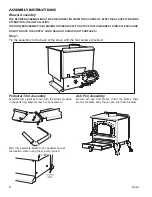
P
AGE
28
O
PERATING
Y
OUR
H
EATER
B
EFORE
Y
OU
B
EGIN
READ THIS ENTIRE MANUAL BEFORE YOU INSTALL AND USE YOUR
NEW HEATER. FAILURE TO FOLLOW THE INSTRUCTIONS MAY RESULT
IN PROPERTY DAMAGE, BODILY INJURY, OR EVEN DEATH.
Before starting your first fire make sure you have read the section titled
Safety Precautions
.
Any questions should be referred to your dealer. There are two things you will need to know
before you start your first fire:
PRIMING THE AUGER
The first time you start your heater,
or
if you completely run out of pellets, the auger will need to
be primed by turning the heater on and turning the BURN RATE to "HIGH" for fifteen minutes.
This will allow the pellets to feed up the auger and start to fall into the firepot before you start the
heater. After this "priming" the stove can be started normally.
PAINT CURING
The first time your heater gets up to temperature you will smell the paint on the outside of the
heater curing. This is normal. We recommend that you first fire your heater outside or leave all
of the windows open for a few hours during the first fire.
A W
ORD ABOUT
P
ELLETS
Your heater was designed to burn wood pellets
only. There are some facts you should know
before you buy pellets. The paragraphs below
detail the information you should know.
With the surge in popularity of pellet heaters
came the tremendous increase in pellet demand.
Because pellets are made from wood by-
products, pellet manufacturing is dependent
upon the supply of these by-products and the
quality found therein. Unfortunately, this surge
in pellet manufacturing has led to a decline in
the quality of the raw materials used to produce
the pellets.
P
P
e
e
s
s
e
e
l
l
l
l
t
t
Ideally, pellets should have a very low moisture, ash, dirt, and salt content. Some pellets do not.
Pellets should have a consistent diameter of 1/4", 5/16", or 7 mm. Pellets should also be no
longer than 1 1/2" long. Some pellets are longer. There is no real pellet monitoring agency, so
you must monitor pellet quality yourself.
We Suggest:
Buy only 3 bags of pellets before you purchase a large amount. Burn the pellets in your pellet
heater and check for these signs of poor quality pellets: clinkers develop in the air holes on the
bottom of the firepot (see the section "Maintenance Instructions"); the auger jams for no apparent
reason, and when the hopper is cleaned out, the auger runs again; there is more than one-half cup
of sawdust in the bottom of the bag of pellets; or, the pellets don't burn well on a low B
URN
R
ATE
, and it seems the A
IR
C
ONTROL
has to be pulled out all the way for the pellets to burn (a
sign of wet or dirty pellets). It is best to check one brand of pellets versus another to see the
difference first-hand. The Association of Pellet Fuel Manufacturers has set the following
standards for pellets: density of at least 40 lbs. per cubic foot; 1/4" to 5/16" diameter; length no
greater than 1 1/2"; 8200 BTU's/lb.; moisture under 8% by weight; ash under 1% by weight; and,
salt under 300 parts per million.
Summary of Contents for Avalon 900 PI
Page 1: ......
















































